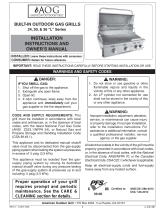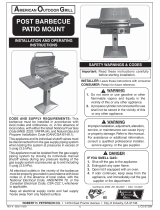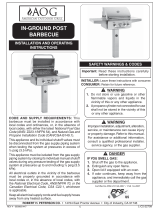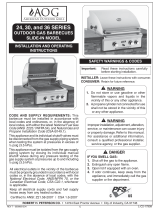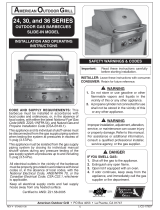
Post Outdoor Gas Grill
(In-Ground and Patio Mount)
Quick Start Guide
3-Installation
Refer to the INSTALLATION REQUIREMENTS section of your grill owner’s manual
for complete details.
CAUTION: Wind blowing into or across the rear oven lid vent (Fig. 3-1)
can cause poor performance and/or dangerous overheating.
Orient the grill so that the prevailing wind blows toward the
front of the grill (Fig. 3-2).
CAUTION: To prevent dangerous overheating, the rear of the unit must have a
minimum clearance of 4” from any non-combustible wall.
CAUTION: WHEN INSTALLING AND OPERATING THIS APPLIANCE, ALL INSTRUCTIONS AND WARNINGS IN
YOUR OWNER’S MANUAL MUST BE OBSERVED. FAILURE TO DO SO MAY RESULT IN A FIRE
OR EXPLOSION CAUSING PROPERTY DAMAGE, BODILY INJURY, OR DEATH.
This grill must be installed in accordance with local codes and ordinances, or, in the absence of local codes, with either the latest National Fuel Gas Code (ANSI
Z223.1/NFPA 54), and Natural Gas and Propane Storage and Handling Installation Code (CSA-B149.1).
This appliance and its individual shutoff valves must be disconnected from the gas-supply piping system when testing the system at pressures in excess of ½ psig.
This appliance must be isolated from the gas-supply piping system by closing its dedicated manual shutoff valve during any pressure testing of the gas-supply
system at pressures up to and including ½ psig.
This grill is designed for outdoor use only. DO NOT use this grill inside a building, garage, or enclosed area (see paragraph below). DO NOT use this grill
in or on a recreational vehicle or boat.
A minimum 5 foot clearance is required between the cooking surface and the overhead construction. When installed under combustible overhead construction,
the area above the cooking surface of the grill must be covered with an exhaust hood. The exhaust hood provides the protection for the combustible overhead
construction. DO NOT use this appliance under unprotected combustible overhead construction. When installed under overhead non-combustible construction,
an exhaust hood is highly recommended. When using an exhaust hood: the area above the cooking surface of the grill must be covered with a hood larger than
the cooking area of the grill, and with a minimum of 1200 CFM (cubic feet per minute) for proper outdoor application.
2-Unpacking
Carefully unpack the grill, removing all packing material and protective film (including the clear
film on the drip tray). Verify that all parts have arrived undamaged by consulting the parts
list in the owner’s manual. Remove foam packed hardware from oven area. (See Fig. 2-1.)
Consult the parts list in the owner’s manual. If any parts are missing or damaged, immediately
contact the AOG dealer before beginning installation.
Fig. 2-1
1-Safety
Lift out foam packed hardware
Remove plastic
zip-ties
Location
Installation must be performed by a qualified professional service technician.
These quick start instructions assume a patio mount installation with a natural gas or household propane configuration. See main instructions
for propane cylinder and/or in-ground post installation.
Note: This section is only an overview of installation to the gas supply. Refer to the grill owner’s manual for complete grill installation details.
To route flex connector through rear of post, unscrew and carefully open the access plate on the rear of the post using a medium Phillips-head screwdriver.
Retain the screws. Remove the knock-out disk at the bottom right of the access plate with a large flathead screwdriver. Remove the plastic grommet (attached
to the flex connector) and insert it into the newly created opening. Then route the flex connector through the opening. See Fig. 3-3. Turn OFF the gas supply
at the source. Then connect the flex connector to the gas-supply. Use pipe joint compound that is resistant to all gasses on the male pipe fittings except
flare fittings.
Turn all burner control knobs to the OFF position. Turn the gas supply on. Then carefully check all gas connections for leaks with a brush and half-soap/half-
water solution before lighting. NEVER USE A MATCH OR OPEN FLAME TO TEST FOR LEAKS.
Proper grill airflow must be maintained as shown in Fig. 3-4. Do not block the 1" front air inlet. It is not necessary to remove the control panel or knobs
for installation.
Connect Gas supply
Route Power Supply Cord
Remove the knock-out disc at the bottom left of the
access plate with a large flathead screwdriver. Remove
the plastic power cord bushing attached to the power
cord, then feed the power cord through the newly created
hole. Install the bushing onto the power cord and slide
the bushing up against the access plate knock-out hole
and snap into place. See Fig. 3-3.
IMPORTANT: You must read the installation and owner’s manual provided with the grill.
INSTALLER: Leave these instructions with consumer. CONSUMER: Retain for future reference.
REV 2 - 1901141420
L-C2-487
"L" Series
Fig. 3-2
CORRECT
PLACE GRILL SO PREVAILING WIND
BLOWS TOWARD FRONT OF GRILL
YOU MUST PROTECT REAR OVEN
VENT FROM PREVAILING WIND
Rear oven lid vent
INCORRECT
Fig. 3-1
Maintain proper ventilation
airflow
Fig. 3-4
Wire Connections
(may need to be
disconnected
durning installation)
AdapterFlex
connector
To gas supply
(as applicable,
flex location
may vary)
To 120VAC
(15 AMP min.)
GFCI
GROUNDED
3-wire
receptacle
Rear
View
Fig. 3-3
Bushing
Grommet
(1" front air inlet)

Read Here
Fig. 5-1
6-Propane and Natural Gas Safety
FOR PROPANE CONFIGURATIONS; READ ALL SAFETY INSTRUCTIONS AND WARNINGS REGARDING THE USE
OF PROPANE GAS FOUND IN YOUR OWNER'S MANUAL. FOR NATURAL GAS READ ALL SAFETY INSTRUCTIONS
AND WARNINGS FOUND IN YOUR OWNER'S MANUAL.
7-Routine Maintenance
Your grill must be serviced and maintained properly to ensure optimal performance, appearance, and safety. Clean your grill before and
after each use. Additionally, a deep clean of the entire grill and all its components be performed twice a year (or as needed depending
on use). See owner’s manual for details.
REV 2 - 1901141420
L-C2-487
4-Grill Setup
Parts Placement Checklist
Place the following items according to their position and orientation
in Fig. 4-1:
Vaporizer panels, cooking grids, and warming rack.
Leave pre-installed burners in place to maintain proper alignment.
Vaporizer Panels
Place the vaporizer panels directly onto the studs on the burners. The
panels allow heat from the burners to be evenly distributed throughout
the cooking area.
Cooking Grids
Place the cooking grids (over the burners) onto the grill frame.
Warming Rack
The warming rack comes pre-installed. Remove zip ties before use.
Consult the owner’s manual to remove or replace.
Rigid Shelves
This grill comes with two (2) rigid shelves that must be attached.
These can be attached using the four support screws provided and
a Phillips-head screw driver.
IMPORTANT: See your grill owner’s manual for complete installation
details.
Fig. 4-1
Cooking grid
Vaporizer panel
(not with IR)
Warming
rack
Note: For infrared burner (IR) equipped
grills, see detailed instructions
included in your owner's manual.
Drip tray
Light
switch
Grill lights
(not shown)
Ignition
switch
Main burner *
Replacement parts can be ordered
from your local AOG dealer.
Backburner
(if equipped)
Timer
valve
Patio mount
hardware kit (4)
To set the timer, turn the dial clockwise to the desired time to shut off. The dial is marked in 3 twenty minute
increments (any position in between is an estimate of that set time). The timer dial will auto rotate (counter-
clockwise) and will shut off the gas supply when the dial reaches OFF (i.e. the time is completed).
Note: Grill must be connected to 120VAC power for electronic lighting.
1. Open lid(s) or remove cover(s) from burner(s) to be lit.
2. Turn all gas control knob(s) to their OFF position(s).
3. Turn on the gas at its source.
Note: DO NOT turn on more than one valve at a time for either electronic or manual lighting.
4. Set timer control knob to the desired cooking time.
5. Depress the control knob for the burner to be lit and turn it to the HI LIGHT position, then press the
ignition button. Once the burner lights, release the ignition button.
CAUTION: If a burner does not light within five (5) seconds of turning on the control
knob, depress the knob and turn it to the OFF position. WAIT FIVE (5) MINUTES
before repeating step 5. If the burners still do not light after several attempts, refer to the
grill owner's manual for manual lighting.
6. Repeat step 5 for each additional burner to be lit.
Fig. 5-3
Backburner
control knob
(if equipped)
Right
main burner
control knob
Left
main burner
control knob
Drip
tray
Control panel
screw(s)
Ignition
switch
The light switch is push button operated,
and is located on the right side of the
control panel (see Fig. 5-3). It controls
the power to all lights.
5-Test
*
The burner
ports and carry-
over ports must
be kept clean to
ensure proper
ignition and
operation.
Light
switch
‡
‡
For your convenience and safety;
when the control knob is turned to
the ON position, the gas flow indicator
will change from blue to red. (Red
indicates gas flow.) See Fig. 5-2.
Fig. 5-2 - Burner valve control knob
OFF
HI
LIGHT
LOW
T O
TURN OFF
T O TURN ON
Read setting
here
HIGH to
LIGHT
Read setting here
(OFF position shown)
To Turn OFF
To Turn ON
Use
HI (high)
to light
Press
knob in
to turn
Gas Flow
Indicator
WHEN OPERATING THIS GAS APPLIANCE,
ALL INSTRUCTIONS AND WARNINGS
MUST BE OBSERVED. FAILURE TO DO SO
MAY RESULT IN A FIRE OR EXPLOSION
CAUSING PROPERTY DAMAGE, BODILY
INJURY, OR DEATH.
Rotisserie Kit
(if equipped)
Rigid Shelf
/
